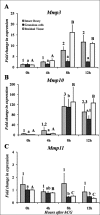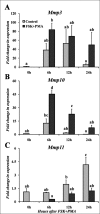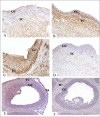Ovarian expression and regulation of the stromelysins during the periovulatory period in the human and the rat
- PMID: 22116802
- PMCID: PMC3316269
- DOI: 10.1095/biolreprod.111.095588
Ovarian expression and regulation of the stromelysins during the periovulatory period in the human and the rat
Abstract
The matrix metalloproteinases (MMPs) are postulated to facilitate follicular rupture. In the present study, expression of the stromelysins (MMP3, MMP10, MMP11) was analyzed in the periovulatory human and rat ovary. Human granulosa and theca cells were collected from the dominant follicle at various times after human chorionic gonadotropin (hCG). Intact rat ovaries, granulosa cells, and residual tissue (tissue remaining after granulosa cell collection) were isolated from equine CG (eCG)-hCG-primed animals. Mmp10 mRNA was highly induced in human granulosa and theca cells and intact rat ovaries, granulosa cells, and residual tissue. Localization of MMP10 to granulosa and theca cells in both human and rat ovarian follicles was confirmed by immunohistochemistry. Mmp3 mRNA was unchanged in human cells and rat granulosa cells, but increased in intact rat ovaries and residual tissue. Mmp11 mRNA decreased following hCG treatment in human granulosa and theca cells as well as rat granulosa cells. Regulation of Mmp10 in cultured rat granulosa cells revealed that the EGF inhibitor AG1478 and the progesterone receptor antagonist RU486 suppressed the induction of Mmp10 mRNA, whereas the prostaglandin inhibitor NS398 had no effect. Studies on the Mmp10 promoter demonstrated that forskolin plus PMA stimulated promoter activity, which was dependent upon a proximal AP1 site. In conclusion, there are divergent patterns of stromelysin expression associated with ovulation, with a marked induction of Mmp10 mRNA and a decrease in Mmp11 mRNA, yet a species-dependent pattern on Mmp3 mRNA expression. The induction of Mmp10 expression suggests an important role for this MMP in the follicular changes associated with ovulation and subsequent luteinization.
Figures







Similar articles
-
Expression and regulation of stromal cell-derived factor-1 (SDF1) and chemokine CXC motif receptor 4 (CXCR4) in equine and bovine preovulatory follicles.Mol Cell Endocrinol. 2014 Jun 25;391(1-2):10-21. doi: 10.1016/j.mce.2014.04.009. Epub 2014 Apr 28. Mol Cell Endocrinol. 2014. PMID: 24784705
-
Regulation of matrix metalloproteinase-19 messenger RNA expression in the rat ovary.Biol Reprod. 2004 Dec;71(6):1796-806. doi: 10.1095/biolreprod.104.031823. Epub 2004 Jul 30. Biol Reprod. 2004. PMID: 15286033
-
Induction of Ectonucleotide Pyrophosphatase/Phosphodiesterase 3 During the Periovulatory Period in the Rat Ovary.Reprod Sci. 2017 Jul;24(7):1033-1040. doi: 10.1177/1933719116676394. Epub 2016 Nov 20. Reprod Sci. 2017. PMID: 27872196 Free PMC article.
-
Regulation and function of tissue inhibitor of metalloproteinase (TIMP) 1 and TIMP3 in periovulatory rat granulosa cells.Endocrinology. 2009 Aug;150(8):3903-12. doi: 10.1210/en.2008-1141. Epub 2009 Apr 23. Endocrinology. 2009. PMID: 19389837 Free PMC article.
-
MMPS and TIMPS in ovarian physiology and pathophysiology.Front Biosci. 2004 Sep 1;9:2474-83. doi: 10.2741/1409. Front Biosci. 2004. PMID: 15353300 Review.
Cited by
-
New insights into the ovulatory process in the human ovary.Hum Reprod Update. 2025 Jan 1;31(1):21-47. doi: 10.1093/humupd/dmae027. Hum Reprod Update. 2025. PMID: 39331957 Free PMC article. Review.
-
Induction of proteinases in the human preovulatory follicle of the menstrual cycle by human chorionic gonadotropin.Fertil Steril. 2015 Mar;103(3):826-33. doi: 10.1016/j.fertnstert.2014.11.017. Epub 2014 Dec 13. Fertil Steril. 2015. PMID: 25516084 Free PMC article.
-
Transcriptomics of cumulus cells - a window into oocyte maturation in humans.J Ovarian Res. 2020 Aug 12;13(1):93. doi: 10.1186/s13048-020-00696-7. J Ovarian Res. 2020. PMID: 32787963 Free PMC article.
-
Ovulation: Parallels With Inflammatory Processes.Endocr Rev. 2019 Apr 1;40(2):369-416. doi: 10.1210/er.2018-00075. Endocr Rev. 2019. PMID: 30496379 Free PMC article. Review.
-
Metalloproteases in gonad formation and ovulation.Gen Comp Endocrinol. 2021 Dec 1;314:113924. doi: 10.1016/j.ygcen.2021.113924. Epub 2021 Oct 2. Gen Comp Endocrinol. 2021. PMID: 34606745 Free PMC article. Review.
References
-
- Curry TE, Jr, Smith MF. Impact of extracellular matrix remodeling on ovulation and the folliculo-luteal transition. Semin Reprod Med 2006; 24: 228 241 - PubMed
-
- Curry TE, Jr, Osteen KG. The matrix metalloproteinase system: changes, regulation, and impact throughout the ovarian and uterine reproductive cycle. Endocr Rev 2003; 24: 428 465 - PubMed
-
- Ohnishi J, Ohnishi E, Shibuya H, Takahashi T. Functions for proteinases in the ovulatory process. Biochim Biophys Acta 2005; 1751: 95 109 - PubMed
-
- Goldman S, Shalev E. MMPs and TIMPS in ovarian physiology and pathophysiology. Front Biosci 2004; 9: 2474 2483 - PubMed
-
- Murdoch WJ, Gottsch ML. Proteolytic mechanisms in the ovulatory folliculo-luteal transformation. Connect Tissue Res 2003; 44: 50 57 - PubMed
Publication types
MeSH terms
Substances
Grants and funding
LinkOut - more resources
Full Text Sources
Research Materials
Miscellaneous

